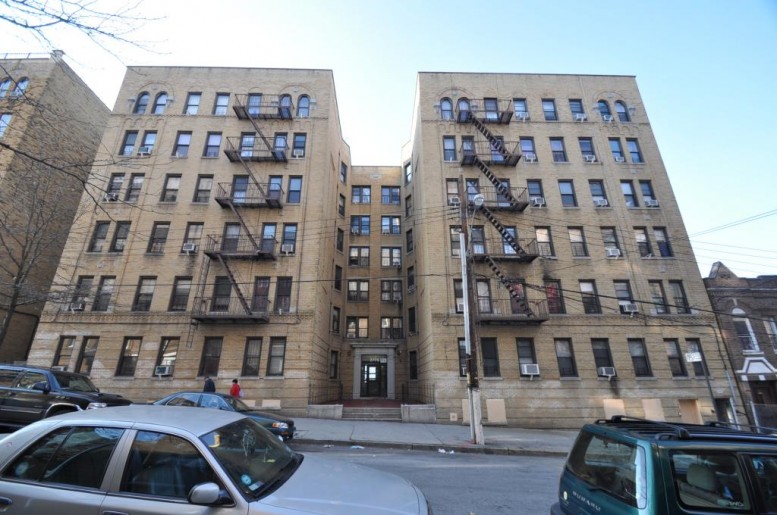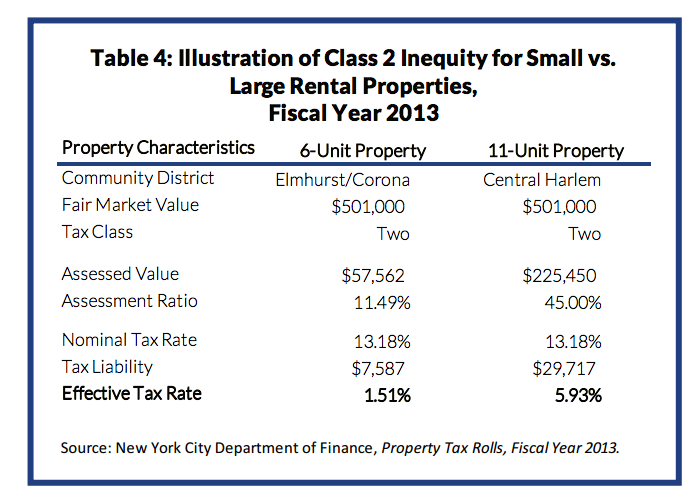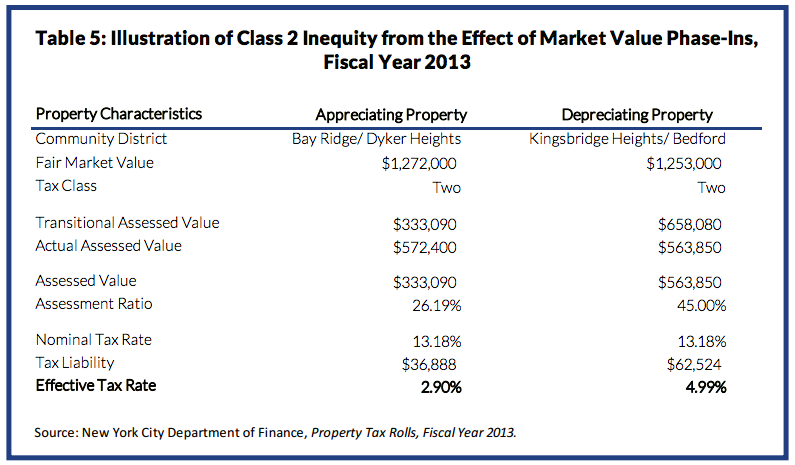While the mayor and the governor sling mud over 421-a, neither leader has devoted much energy to fixing New York’s byzantine and inequitable property tax system, which hasn’t been reformed in more than 30 years.
In 1981, the state passed a law that created four different tax classes: Class 1 is single family homes and small condo or rental buildings up to three units. Class 2 includes all apartment buildings larger than four units, whether they’re rentals, condos, or co-ops. Class 3 is utility buildings, and all commercial properties, including big office towers, are assigned to Class 4.
However, the effective tax rate for each property class is wildly different, and one to three family homeowners pay a much lower tax rate than larger rental and condo properties do (as YIMBY has discussed before). Houses, aka Class 1 properties, make up nearly three quarters of the city’s property and half its tax value, yet they only pony up 15% of its taxes, according to the Citizens Budget Commission.
On the other hand, apartment buildings with more than four units hold 23% of the city’s tax value, but shoulder more than a third of its tax burden. And since low-income New Yorkers are almost exclusively renters, the city’s property tax system indirectly punishes them. It also penalizes developers and landlords, who ultimately pass their inflated tax bill onto tenants in the form of higher rents.
The gap in taxes has become so large that two tenants in the South Bronx and eastern Queens filed suit against the state earlier this year, arguing the higher tax rates for large rental buildings disproportionately affect black and Hispanic residents, who make up a higher percentage of renters than whites or Asians. Unfortunately, the suit was thrown out in April.
And state-imposed tax caps complicate the issue even more. The assessed value of Class 1 buildings can’t grow more than six percent in a year or 20% over five years. Class 2 apartment buildings with four to 10 units are similarly capped, at 8% in a year or 30% over five years.
So properties with 11 units or more shell out higher taxes than their small neighbors, despite “phase-ins” designed to prevent huge tax jumps based on rising property values.
There are also problems with the way co-ops and condo buildings are valued. They get abatements that cut their tax bill by as much as 28%, according to the Citizens Budget Commission. And the bizarre 1981 tax reform law mandated that the city value condos and co-ops based on similar rental buildings. In practical terms, that means pre-1974 co-ops and condos are taxed at the same level as rent-stabilized apartment buildings, even though the market value of rent regulated buildings is often lower.
Until now, the 421-a abatement had prevented taxes on new construction condos from rising at an astronomical rate. But if the legislature decides to approve de Blasio’s plan to scrap 421-a for condos, new owners will end up shelling out much more than their pre-war counterparts.
Even within the same property classes, caps and the city’s flawed assessment system create huge disparities between different neighborhoods. Take these two multifamily buildings with the same market value. The Kingsbridge Heights property pays $62,524 in taxes, 72% more than the comparable building in Bay Ridge, which only owed the city $36,888.
So what happened? In ‘hoods with rapidly increasing property values, tax caps prevent the assessed value from rising more than 5% or 6% a year, explained James Parrott of the Fiscal Policy Institute. Homeowners in places like Carroll Gardens or Park Slope—where housing prices are skyrocketing faster than the assessed value—benefit from the caps. But in areas where prices are stable or depreciating, like the northern Bronx, landlords and owners often pay much higher effective tax rates.
But there are ways to reform our bizarre patchwork of caps, assessment ratios and abatements. Legislators in Albany could choose to scrap the caps and phase-ins in favor of a “circuit breaker.” The measure would offer a lower tax liability or a refund through personal income tax returns. It could benefit both renters and homeowners, especially if it were linked to someone’s income. So low-income tenants or owners behind would reap the most benefits, but struggling middle-class residents would probably still get a check or a lower tax bill.
In order for this to work, the state would have to agree to tax Class 1 properties, condos and co-ops based on their market value.
“The most critical disparity in the city’s property tax rate on condo and co-ops is much lower than it is on rental building,” said Parrott. “You could increase the effective tax rate on co-op, condo, and homeowners and reduce it on rental properties.”
For poorer homeowners, the circuit breaker would offset the higher tax rates and keep them from being priced out of their houses.
Yet selling this plan to the public would be politically difficult. No mayor or governor wants to admit they raised taxes on single-family homeowners, but it may be the best solution to balancing the city’s tax burden. Rental developers, landlords, and ultimately tenants pay far higher property taxes than they should.
Subscribe to YIMBY’s daily e-mail
Follow YIMBYgram for real-time photo updates
Like YIMBY on Facebook
Follow YIMBY’s Twitter for the latest in YIMBYnews




Is property in Bedford Park actually depreciating? NY Times would have you believe all Bronx property is on fire. Curious.
average property taxes were $4,324 for a one-family home, $5,960 for a co-op unit and $7,499 for a condo unit. ( Jan 2013 )
Tired of hearing that apartment buildings are overtaxed. They are large mutlti-unit buildings with huge rent rolls. In effect they are businesses. The 2-family or 3-family homeowner uses the rental income to defray mortgage costs. The 1-family owner has no rental income.
Hey “homeowner” – what is income tax?
Class 2 is 4 and above…